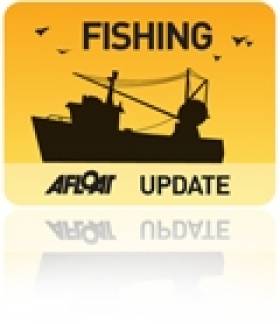Displaying items by tag: Supertrawler
Supertrawler In Irish Waters 'Needs Independent Observer'
#Fishing - Wildlife conservationists have called for an independent observer to be placed aboard a supertrawler previously banned from Australian waters that's returned to Ireland's fishing grounds.
According to The Irish Times, the Irish Wildlife Trust (IWT) has urged Marine Minister Simon Coveney to ensure that the FV Margiris – one of the world's largest fishing boats – is sticking to its quota under the Common Fisheries Policy (CFP) as it fishes off Donegal.
The biggest concern for conservationists is possible by-catch in waters that double as a protected cetacean sanctuary by the 143m vessel, which trawls with enormous nets said be bigger than a football pitch, as the Belfast Telegraph reports.
"It is simply unacceptable that enormous boats like this can move into our waters and hoover up marine life," said IWT campaigns officer Padraic Fogerty.
His concerns were echoed by Irish Fish Producers Organisation (IFPO) CEO Francis O'Donnell, who said that while the boat may be fishing on licence with a quota, "the real worry I would have is that they are not being controlled properly by Irish authorities in Irish waters."
Last year Minister Coveney was forced to assuage concern over the Margiris' fishing activity off the west coast as it has secured an allocation for blue whiting under the CFP.
In other fishing news, The Irish Times says Minister Coveney has promised weekly meetings by the new cross-departmental taskforce established to investigate claims of exploitation in the Irish fishing fleet.
Inspections of fishing vessels began last week, resulting in one Egypptain fisherman charged, but ahead of the latest meeting the minister said: "I don’t want this to be a witchhunt on people who may be here illegally and may be vulnerable."
As previously reported on Afloat.ie, the first meeting of the taskforce took place last Thursday 5 November in the wake of a damning Guardian report alleging the exploitation of undocumented and even trafficked labour in the Irish fishing industry.
The allegations have been criticised by leading industry figures as well as the daughter of the lake skipper of the Tit Bonhomme, which sank tragically in January 2012 taking the lives of three Egyptian fishermen along with her father and a fellow Irish crewman.
Minister Assuages Concerns Over Visiting Supertrawler
#Fishing - A supertrawler previously expelled from Australian waters that has appeared off the west coast is nothing to be worried about, Marine Minister Simon Coveney said at the weekend.
According to The Irish Times, Minister Coveney told concerned fishermen in Galway that the 9,500-tonne FV Margiris, one of the largest fishing trawlers on the seas, is "probably" involved in legitimate fishing after securing an allocation for blue whiting under the Common Fisheries Policy.
He also admitted that the Naval Service had not inspected the vessel to confirm it is abiding by the rules, but that "we take note" of any such super-sized vessels that come into or near Irish waters.
The minister was speaking at the Galway Skipper Expo, the annual international fisheries show that was celebrating its 10th anniversary last weekend.





























































